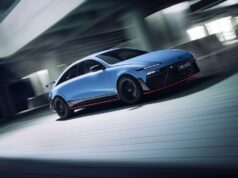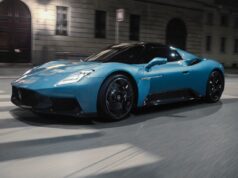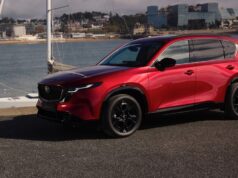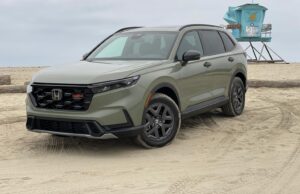
Chevrolet’s all-new 2008 Malibu is just now hitting your local Chevy dealers. GM has high hopes for the Malibu, as the new sedan is one of their most important new releases for the 2008 model year.
The all-new Malibu is very important to GM as the automaker tries to head off Toyota as the number one automaker. Because of this GM went after the segment’s class leading models (Camry, Accord and Altima).
So the main question is: With all the hype about GM’s newest midsize sedan, how does the all-new Malibu stack up against the Toyota Camry, Honda Accord and Nissan Altima?
Recently (as in this past weekend) GM flew me out to Memphis, Tennessee to check out the new Malibu. I had the opportunity to drive the Malibu and its main competitors throughout Memphis and the northern part of Mississippi (actually I only had the chance to drive the competitors in Memphis). I will start this review by saying that I was throughly impressed with what GM has done with the Malibu. The last two generations were very forgettable sedans that could not compete with the Accord or Camry. The 2008 model year can now go down in the history books as the year that Chevrolet finally got serious about the midsize sedan market.
Styling:
Immediately you will notice that the new Malibu actually has style. Designers used various Corvette design elements in the overall design (note the circular dual-lamp tailights.) The front end also has the new face of Chevy cars. With its large front grille and expressive lines the new Malibu is all about getting noticed. GM execs liked to boast that the all-new Malibu has the styling of a $40,000 sedan, but for half the price. What do you think?
GM did not stop with the exterior styling. The interior of the Malibu is definitely one of the better designs in the midsize segment. The head of design made a point to emphasize the “dual cockpit” design of the interior. It’s a very clean design that works well in the Malibu. in some models the dash has a two-toned effect that is anything but boring. All of the controls in the interior are cleanly laid out and the attention to detail is apparent. There’s even an optional AC plug in the back for you to plug in all your accessories (all cars need this).
Performance:
We had the chance to drive all three versions of the new Malibu, the 4-cyl, hybrid, and V6. Of course being a car guy I’m sure you can guess which version I liked most. Yes the V6 is easily the most enjoyable of the three models. With its 252 horsepower and 6-speed automatic the V6 made the “family sedan” seem more like a sport sedan….well almost. The main downside to the V6 was the torque steer that easily outperformed the traction control.
There are two versions of the 2.4L 4-cylinder. The regular 2.4L 4-cylinder features 169 horsepower and is mated to a 4-speed automatic (a six-speed automatic will be available on LTZ models beginning in the Spring). This model was adequate for its class. GM expects that more than half of the Malibu’s sold will be powered by this engine. It achieves 30mpg on the highway and 22mpg in the city. My lead foot proved a little much for the engine, but judging by this models demographic I am sure that it will be more than adequate for their driving needs.
The second version of the 2.4L 4-cylinder features a hybrid setup (mild hybrid). The setup puts out 164 horsepower (5 fewer than the non-hybrid) and gets 2 mpg more on the highway and in the city compared to the non-hybrid. GM stated that there are no plans for dual-hybrid powertrain in the Malibu. I’m sure most of you are wondering what’s the point of hybrid that only gets 2mpg more than the regular version…I’ll come back to this.
The Malibu shares its basic underpinnings with the Saturn Aura, although the suspension has been tuned slightly. Whatever the engineers did to the Malibu’s suspension they should receive praise. The Malibu’s handling on the back country roads of Mississippi definitely ranks higher than the best-selling Camry, although it is not as firm as the Accord or even the Altima. GM told us that the Malibu’s handling would constantly make you question if you could have taken that past curve in the road faster. For the most their claims were true. It’s no BMW, but overall its handling impressed me. I was very happy that the Malibu did not float along the road.
Overall the Malibu’s performance was impressive, although the brakes were not ideal. Multiple times I ended up going through stop signs because the brakes did not bring the car to a stop as fast as I would have liked. It’s a good thing we were in the middle of nowhere or else we would have ended up testing a few of the Malibu’s standard six airbags.
In addition the Malibu’s impressive handling engineers also worked hard to make sure that you could hear your tunes and not the noises from the road or engine. Extra sound-deadening in the floor and dual-paned side glass made the interior almost library quiet. Of course the extra materials added extra weight to the Malibu, but it was worth it.
One big negative that I had with regards to performance was the design of the “paddle shifters” or TAPshift manual shift control according to GM. The two paddle shifters in the Malibu serve the same function, so rather than the left one shifting the transmission down a gear and the right one shifting up or vice versa both of the paddles in the Malibu can shift the transmission up or down. This was very confusing and hard to get used to for many of the drivers. I found myself hitting the red line the first few times because I couldn’t get used to the layout. I guess if you have never driven a car with paddle shifters you could get used to this design, but I could not understand why GM decided to go this route. It eventually frustrated me and I just threw the gear shift back into automatic mode.
Spaciousness:
The all-new Malibu is much bigger than the car it replaces. The Malibu’s wheelbase has been stretched six inches to 112.3 inches (the longest in its class). The overall length has been increased by approximately three inches. This all translates to a a big sedan with a spacious interior. Your passengers should have one less thing to complain about on your road tips with its ample leg room.
So back to the question that was posed at the beginning of this review: With all the hype about GM’s newest midsize sedan, how does the all-new Malibu stack up against the Toyota Camry, Honda Accord and Nissan Altima?
Malibu vs. Camry:
Well all of you that feel that American automakers can not make a good sedan may have to rethink your beliefs. The new Malibu lands squarely in the middle or near the head of the pack. The general consensus at the event was that the Malibu is far better than the best-selling Camry. The styling especially in regards to the interior is far more interesting than the Camry. The Malibu’s 4-cylinder engine also is comparable to the Camry’s, although I’d wait for the six-speed automatic next Spring. Handling is not one of the Camry’s strong points as the Malibu definitely killed the Camry in this area. Although the Malibu’s V6 is a little less powerful on paper than the Camry’s, it manages to keep up. The one thing that the Camry does have over the Malibu is its hybrid variant. The Malibu’s mild hybrid can not really compete with the Camry’s full hybrid powertrain in terms of overall power and gas mileage. The Malibu hybrid gets 24mpg in the city, while the Camry hybrid achieves 34mpg.
Malibu vs. Altima
Next in line is the Nissan Altima. My biggest gripe with the current generation Altima has always been the CVT. I tested an Altima earlier this year and hated its transmission. That feeling still stands today. Although the 4-cylinder Malibu currently only has the 4-speed automatic I’d rather take that than the CVT in the Altima. The Malibu has less horsepower in both versions than the Altima, but the differences are not huge. Although in terms of refinement I would probably take the 3.5L V6 in the Altima over the 3.6L in the Malibu.In terms of styling I liked the Malibu’s interior better. The Altima’s interior design is better than that of the Camry, but still not as interesting to look at as the Malibu’s. Interior plastics are about equal, since both the Malibu and Altima have some hard plastic that I could have done without. Just like the Camry hybrid, the Altima hybrid (which uses some of Toyota’s technology) outperforms the Malibu hybrid.
Malibu vs. Accord
Throughout the whole drive I constantly felt that the Malibu’s biggest competition in terms of performance, handling and overall might as well be the Honda Accord. Both sedans are all-new for 2008 and represent each automaker’s biggest effort in the segment. Both models are larger than their predecessors and feature more expressive exterior and interior styling. The Accord has more power than either the 4-cylinder or V6 Malibu. The Malibu’s 4-cylinder can probably keep up with the Accord’s 4-cylinder, but it is not as refined and the 4-speed automatic seems archaic compared to the Accord’s transmission (remember wait until next Spring). Styling is objective and with any of these sedans we could argue for days about which one looks better. So there is not really any point to discussing it in regard to the Malibu vs. Accord. Some of us may like the new Accord’s interior styling better than the Malibu’s or vice versa. But the biggest gripe I had with the Malibu’s interior were its use of hard plastic everywhere. It had it on the doors, on the back of the front seats, the dash, center console, etc. It’s obvious that GM had to cut costs somewhere and this is where they did it. Compared to the Accord the interior of the Malibu felt cheap. Even the seats felt cheap. Don’t get me wrong they were a good size, but the fabrics in the non-leather versions seemed too hard and very rental car like.
So what did I absolutely not like about the Malibu?:
First off as I’ve mentioned numerous times, the materials used in the interior do not equal the quality of the Accord. The overall design was nice and the two-toned models looked more upscale, but ultimately could have benefited from a slight upgrade. Next, I still do not understand the point of the hybrid model. It only achieves 2 mpg more than the regular 4-cylinder yet it costs about $1,800 more (Yes, GM execs pointed out that after the eligible tax breaks the actual premium would only be $500). I don’t understand why they wasted the time and energy to create something that doesn’t really provide a large benefit. If I wanted a midsize hybrid sedan I would probably go with the Altima or Camry since they have better performance. Yes the Malibu hybrid is the cheapest hybrid in its class or maybe even on the market as a whole, but it still didn’t win me over. Next, why is Bluetooth and an in-dash navigation system not offered? Yes, GM does have the Onstar system which offers hands-free calling. But don’t let that deceive you. You have to pay extra for this feature, for example its $14.99 for 100 minutes. Does that sound like something you want to pay for when the Malibu’s competitors offer Bluetooth, which does not require a monthly fee? I overheard a GM exec mention something about the fact that Malibu drivers do not place Bluetooth on their list of priorities. Is that really true? In addition to the hands-free calling issue, an in-dash navigation system is missing from the options list. Once again you must rely on Onstar to guide you to your destination. It’s another way for GM to continue to make money on you after you already fork over the initial money for the Malibu.
Conclusion:
Overall the 2008 Malibu is one of the best, if not the best domestic midsize sedan and at $19,995 it represents a great value. Will it steal the top selling spot from the Camry? Probably not. Don’t get me wrong, the Malibu represents a great effort from GM, but GM, Ford and Chrysler still have a long way to go to prove to the car buying public that its products are comparable or maybe even better than their competitors. But, Honda and Toyota better take note. The days of the uncompetitive American sedan are now over.
Malibu Pros:
-Exterior and Interior Styling
-Interior Passenger Room
-Quiet Interior
-Good Handling
-Available Two-toned interior
-Available AC plug
Malibu Cons:
-4-Speed Automatic on 4-cylinder (6-speed auto available on LTZ in Spring 2008)
-Interior Plastics (Hard plastic dominates interior)
-Mild hybrid does not compare to Camry and Altima hybrids
-Bluetooth not available
-In-dash Navigation not available
-Lackluster brakes
-Weird placement of mirror adjuster
-Hard cloth seats
-No SS variant planned
-Paddle Shifters (TAPshift)
Pricing:
-LS: $19,995
-1LT: $20,955
-2LT: $22,635
-LTZ: $26,995
-Hybrid: $22,790




























Related Stories:
GM Sold More Vehicles Than Toyota Last Quarter…Is GM Making a Comeback?
2008 Chevrolet Malibu Hybrid Revealed…To Bad it Only Gets 2mpg More Than the Normal Version!
VIDEO: GM’s Bob Lutz Explains Why You Should Buy the All-New 2008 Chevy Malibu
2008 Chevy Malibu Review…Coming Soon
2008 Chevrolet Malibu Starts at $19,995…Is it Better than the New Honda Accord?








